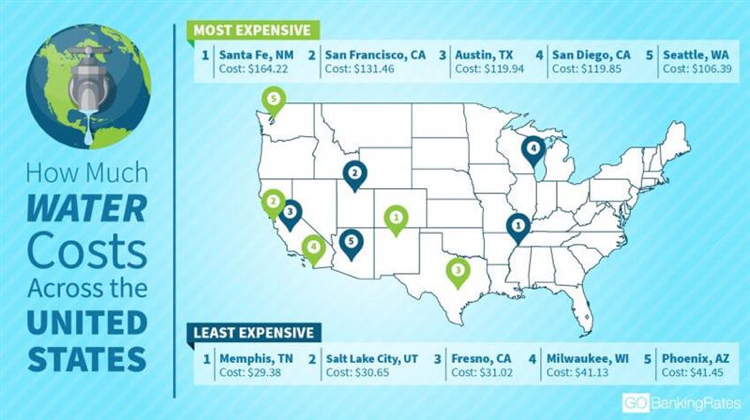On September 21, 2021, the NOAA released data demonstrating that the Southwestern United States’ precipitation levels were the lowest documented since 1895, attributed to human-caused climate change. This report also noted that this severe drought caused states neighboring the Colorado River to experience their first-ever water delivery shortfalls.
As climate change continues to cause such challenging scenarios, designers are at a critical juncture and must recognize and act on the human-life necessity of water. It is essential to use design as a method to maintain its primacy and value. Designers must consider that water is as precious a resource as energy, although it is not often discussed as a commodity. In the broader built environment, energy and carbon are often first discussed as the largest pieces of the puzzle, but water plays an equally critical role in decarbonization and maintenance of resources.
Water Governance & Cost
The regulation and governance of water presents a complex framework that encompasses water quality, safety standards, and contamination and sanitation requirements. All of these directly contribute to human health and wellbeing. It is imperative that designers investigate and consider who is supplying our water – and where it originates. Municipal and private water utilities have come under fire in recent years for devaluing water, revealing a large disparity between the perceived value of water and the price paid per gallon.

Image Source: The Price of Water Across America | GOBankingRates
Although we can recognize in desert climates or in areas without access to natural freshwater streams that water is more precious, utility pricing is not necessarily indicative of those trends. The West Coast continues to face some of the largest droughts and longest seasons of drought anywhere in the world, yet it remains variable in terms of utility pricing for water. Do you know how much your water is truly worth from beginning to end? Climate change is not yet recognized within these pricing mechanisms, although it should be. The cost pales in comparison to its value and necessity in our daily lives. Knowing this, we must continue to be active stewards to our water resources and identify ways in which water can be more thoughtfully consumed and reused to reduce overall use and ameliorate water stress in the face of a changing climate.
Five Steps for Assessing the Impacts of Water
- Understand What’s Using Water: Metering
How much water is being using, and who or what is using the most? Although this may seem elementary, in order to understand how to begin making changes to the way we use water, we need to first understand use patterns and consumption trends. Metering helps identify where the majority of our water consumption happens, where the reductions are most needed, and where changes would be most impactful. Water metering can also help inform end-users of any leaks or other sources of unseen water loss, helping them avoid wasting clean water and getting excessive water bill charges.
Water metering has become business-as-usual for commercial buildings and projects, but it is also achievable at a residential scale. State, municipal and company-specific rebates are now being offered across the country for water metering, identifying priority areas that are most stricken with drought.
2. Designing Out Excess: Reducing Water Demands
Similar to discussing waste, water conservation can be examined by following a “reduce, reuse, recycle” strategy. The first step is to reduce water consumption. High-performance building rating systems, such as LEED (Leadership in Energy and Environmental Design) and the LBC (Living Building Challenge), have helped make commonplace the utilization of highly efficient fixtures these days, including low-flow (and no-flow!) technologies. Whether it’s a dual flush toilet, a composting toilet or an aerator added to a faucet to allow for reduced potable water use indoors or the use of native and adaptive plantings to reduce water demand outdoors, effective and widely available strategies have been well developed, and for good reason – they are the easiest and most accessible path to reducing water demand.
3. Identifying Water and Energy Synergies: Heating Water Systems
Residential properties are the inherent focus for hot water consumption due to their use patterns. Manufacturing facilities, while important, present more difficulty in achieving the same degrees of conservation. Hot water consumption greatly impacts homes, making up approximately 17-32% of the energy consumption in most residences. Water use and energy use, in this case, are synergistic and reductions can be made simultaneously in both.
Over 10% of all hot water produced in residential applications is wasted, a phenomenon we notice every day while we wait for the water to heat up and we inevitably turn our attention to other quick tasks. That accounts for nearly 280 million gallons of water per day in the United States alone. Water and energy are, figuratively and literally, going right down the drain. A key strategy to reducing this waste is specifying and using instant hot water heaters or tankless water heaters, or both. These systems heat water closer to the point of use, minimizing the time, water and energy wasted to bring water to a desired temperature and to require it to travel from the heating source to the point of use, whether a showerhead, a sink faucet, or the like.
Another, more recent strategy is the addition of a thermostatic shut-off valves on showerheads. These valves are inexpensive to purchase and easy to find at any big-box home improvement store. Instead of water running continuously until someone hops into the shower, the valve senses the water temperature and once hot, automatically shuts off the flow until a chain is pulled. This can reduces several minutes of wasted hot water per use, multiplied when by the multiple residents living in a home or multifamily dwelling.
4. Reusing Water: Outdoor Applications
With green building frameworks and municipal codes continuing to require zero-to-low potable water for use in irrigation and other landscape systems, it is imperative that reuse be implemented at any scale to ameliorate freshwater use in exterior spaces. Stormwater collection for projects helps not only in managing run-off, but it also provides an opportunity for water reuse. Water collected can be used for irrigation, mechanical make-up for a cooling tower (after some treatment), and — where allowed by the local jurisdiction — for toilet and urinal flushing.
As climate change continues to progress, having a collection tank can help in both extremes. First, in a drought, it can serve as a water source for non-potable needs. Second, in case of flooding, the tank would be able mitigate excess run-off and prevent the overburdening of the stormwater systems.
5. Reusing Water: Indoor Applications
Similarly, green building frameworks and municipal codes also widely require low-flow indoor plumbing fixtures, layering in water reuse is the natural progression for reducing potable water use to get to net-zero water. Reusing non-potable water for irrigation, mechanical make-up for cooling towers, and toilet and urinal flushing is not only an outdoor strategy: the same can be done with indoor fixtures. Greywater collected from indoor fixtures, such as shower drains, can be reused in the same fashion.
Water studies conducted on Buro Happold’s multifamily residential projects indicate that greywater collected from shower drains can provide more than double the water needed for flushing on the same premises. Since occupant use patterns for both fixtures are nearly identical, the pairing is an easy fit and it makes for the perfect water reuse opportunity.
Moving Forward
Ultimately, the way that buildings manage and utilize water has impacts far beyond the boundaries of our homes or commercial and institutional properties. Access to fresh water is an inherent part of maintaining social value and ensuring that the true definition of sustainability is upheld: creating “development that meets the needs of the present without compromising the ability of future generations to meet their own needs,” as stated by Our Common Future.



